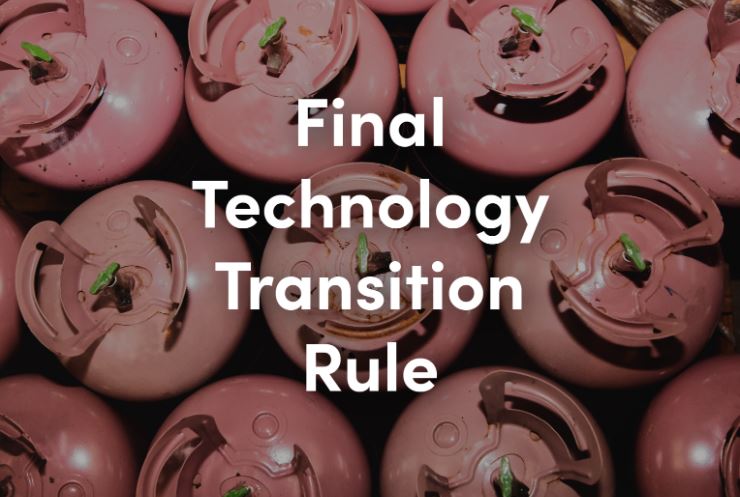2023 – EPA Releases Final Technology Transition Rule Limiting Refrigerants Used in Future Equipment*

The Environmental Protection Agency (EPA) has finalized its technology transition rule, which limits the GWP of refrigerants used in comfort cooling and refrigeration equipment. The finalized rule will prohibit manufacturing or installing most equipment using current high-GWP refrigerants as early as January 1, 2025, depending on the sector and sub-sector and if the equipment is considered a product or a system. EPA has made it clear that repairs to existing systems or retrofits to change refrigerants in existing systems are not prohibited by the rule. This means parts and components for repair/retrofit can still be manufactured and sold past the compliance deadline.
The EPA released the pre-publication version of the rule on October 6, 2023, and changes can potentially be made to the rule before its publication in the Federal Register. Unfortunately, changes made to the rule between its proposal and final versions have created confusion about how many products are treated in determining its compliance date. EPA created two categories of equipment, products and systems, each with its compliance regime. The final rule defines the two categories:
Product means an item or category of items manufactured from raw or recycled materials which performs a function or task and is functional upon completion of manufacturing. The term includes, but is not limited to: appliances, foams, fully formulated polyols, self-contained fire suppression devices, aerosols, pressurized dispensers, and wipes.
System means an assemblage of separate components that typically are connected and charged in the field with a regulated substance or substitute to perform a function or task.
Equipment qualifying as a product has a manufacturing prohibition with a three-year sell-through on remaining inventory. Equipment qualifying as a system has an install date prohibition. The manufacturing and installation prohibitions fall on the same date for all sectors and sub-sectors. For example, a window air conditioner using a high-GWP refrigerant cannot be manufactured after January 1, 2025, and a split-system air conditioner using a high-GWP refrigerant cannot be installed after January 1, 2025.
This two-definition regulation creates inconsistency for HVACR equipment. The background text described the restriction on products that are self-contained, a term not in the regulatory definitions, to be a January 1, 2025, manufacturing prohibition and a three-year sell-through. This means a package air conditioner, which is functional upon completion of manufacturing, is a product. In contrast, a split-system air conditioner, which requires an installer to complete the refrigerant circuit, is considered a system and must be installed before January 1, 2025. This means the two pieces of equipment, while very similar in function, face two very different regulatory regimes.
EPA also provided two additional definitions that further confuse the intent of the regulation:
Manufacture means to complete the manufacturing and assembly processes of a product or specified component such that it is ready for initial sale, distribution, or operation.
Install means to complete a field-assembled system’s circuit, including charging with a full charge, such that the system can function and is ready for use for its intended purpose.
From reading the explanation of the final rule, each definition supports one of the two categories: manufacture aligning with products and install aligning with systems. A manufactured product is ready for operation when it leaves the factory and installed products require expert installation before operation. But, again, products like package units and split systems are cast into very different regulatory regimes despite being very similar products.
In addition to the confusion created by the two categories, HARDI is also disappointed any part of the rule comes with an install date requirement. HARDI pushed for using manufacture date compliance on all products to ensure distribution can deplete its inventory of all remaining systems. Even the three-year sell-through provided by EPA goes against the fundamental principle that distribution should not be forced to discard functional equipment because of a regulatory regime.
Another concerning component of the final rule is an export ban on products manufactured to use high-GWP refrigerants. While the U.S. is moving forward with its transition, Canada and Mexico are moving on slower timelines. The export ban will impact U.S. manufacturers who are unable to export products past the compliance deadline and hurt distributors working in Canada and Mexico because they will be unable to move products from the U.S. after the compliance date. The final rule allows the continued export of components, including condensing and evaporator units.
The GWP limits set by the final rule align with the industry petition and proposed rule, with comfort cooling having a GWP limit of 700 and commercial refrigeration having a limit of 700, 300, or 150, depending on the end-use. HARDI joined several others in the industry in requesting a later compliance date for commercial refrigeration because the SNAP program has not yet approved the replacement refrigerants and the final rule moved back the compliance deadline for most of these products.
*Taken from Hardinet.org October 10, 2023
Find the Technology Transitions HFC Restrictions by Sector at the link below:
Technology Transitions HFC Restrictions by Sector
